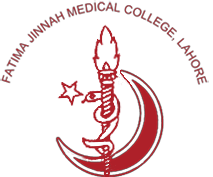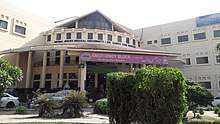Fatima Jinnah Medical University
Fatima Jinnah Medical University (Urdu: جامعہ طبی فاطمہ جناح), previously known as Balak Ram Medical College, is a medical school located in Lahore, Punjab, Pakistan. Fatima Jinnah Medical University with its associated teaching hospital Sir Ganga Ram Hospital, is a medical institution to teach and train female doctors and post-graduate students and provide medical and healthcare facilities to the citizens of the country, particularly in and around Lahore, and more particularly to the female population. It is now a tertiary healthcare unit.
 | |
| Type | Public |
|---|---|
| Established | March 1948 |
| Founder | Prof. Dr Shujaat Ali |
| Vice-Chancellor | Prof. Amir Zaman Khan |
Academic staff | 160 |
| Students | 1500 |
| Location | , , |
| Colors | Upsdell Red |
| Affiliations | Sir Ganga Ram Hospital Pakistan Medical & Dental Council |
| Website | Official website |
Sir Ganga Ram Hospital was established in 1921 in the walled city of Lahore by a philanthropist Sir Ganga Ram who also donated a piece of land. The hospital was shifted to its present location in 1943 to cope with the growing demand for medical and health care services.[1]
On June 30, 2015 the Health Department of Pakistan changed the status of the Medical College to the Medical University and the current principal was made the Vice Chancellor of the University.[2]
History
In 1941 the family of Sir Ganga Ram started a medical college by the name Balak Ram Medical College named after a son of Sir Ganga Ram.[3] Soon after independence in 1947, the college was closed and its premises abandoned. However, the medical professional Prof. Shujaat Ali with the help of his colleagues nurtured the idea of setting up a medical institution in the same premises for teaching female doctors. With this objective the team of Prof. Shujaat Ali asked the approval of Quaid-e-Azam Muhammad Ali Jinnah for the institution to be named after his sister Mohtarma Fatima Jinnah. The Quaid approved the use of her name. Fatima Jinnah Medical College For Women, Lahore admitted its first batch of 39 students in October 1948 and was formally inaugurated in March 1949 by Khawaja Nazim-ud-Din, the Prime Minister of Pakistan.[4][5]
Facilities
The Library of the institution is well equipped with all modern facilities according to the HEC criteria. Library membership is free for all enrolled students. It has a collection of 47000 volumes comprising text books & reference books on all disciplines of health sciences. Text book service is available in the library. For that purpose a book bank is working for last 16 years with 5500 books. WHO corner also has been established in library for reference and research. There is a holding list of 27500 core medical journals present in the library journals section. 37 national and 15 international journals are on our regular list. Nearly 35 videos on different health related topics are available in library. Almost 130 CD’s of medical books are available in library. A general books section comprising 700 literary books is available for students. Networking of the departments of the University and hospital is being planned with linkages to other national and international universities. There is free internet facility in the library.[6][7]
The Audio Visual Department has been provided with new computers and eight multimedia systems for lectures.
The hostel for students consists of seven blocks. There are around one thousand students living in the hostel. There are facilities for outdoor and indoor games, a gymnasium and a swimming pool. The University operates seven buses for the day scholars.[5]
Ganga Ram Hospital

Sir Ganga Ram Hospital, situated in the heart of city, close to the main artery of Lahore (Shahra-i-Quaid-iAzam) and Punjab Assembly, is the teaching hospital of FJMU. Surrounded by thickly populated area the hospital caters to the western and southern part of the city and provides services to adjacent districts of Lahore. The bed strength of the hospital is 700, but the average number of admissions usually touches 800. The complex covers 314 kanals (about 16 hectares).[5]
Admissions
Fatima Jinnah Medical University admits 250 students every year. 50% of the seats are reserved for the Federal Government and in these seats students from Sindh, KPK, Balochistan, FATA, PATA, AJK and Northern Areas are admitted. 23 seats are reserved as PTAP (Pakistan Technical Assistance Programme) for the friendly and Islamic countries.
Fatima Jinnah Medical University also conducts JCAT (Joint Centralized Admission Test).[8]
FJMU alumni have a strong presence in North America. The North America wing of FJMU's alumni[9] holds annual meetings and is engaged in projects to help FJMC students, researchers and faculty.
Affiliations
The degree is granted by the University of Punjab, one of the oldest medical degree awarding institute of Pakistan, and is recognised by Pakistan Medical and Dental Council and College of Physicians and Surgeons Pakistan.[10][11]
References
- "Sir Ganga Ram Hospital | FJMU". www.fjmu.edu.pk. Retrieved 24 June 2019.
- Chaudhry, Asif (30 June 2015). "From FJMC to FJMU, principal to acting VC". Dawn.com. Retrieved 9 November 2017.
- "Balakram Medical College Archives". Indian Memory Project. Retrieved 24 June 2019.
- "Fatima Jinnah Medical University (FJMU)". Dr. Najeeb Lectures. Retrieved 24 June 2019.
- "Official website of the Fatima Jinnah Medical College". Fjmc.edu.pk. Archived from the original on 17 December 2007. Retrieved 9 November 2017.
- "Library | FJMU". www.fjmu.edu.pk. Retrieved 24 June 2019.
- "E-library | FJMU". www.fjmu.edu.pk. Retrieved 24 June 2019.
- "JCAT - Joint Centralized Admission Test". Nustweb.blogspot.com. Retrieved 9 November 2017.
- "FJMC Alumni Association of North America". Fjmcna.net. Archived from the original on 10 September 2010. Retrieved 9 November 2017.
- Archived 29 November 2010 at the Wayback Machine